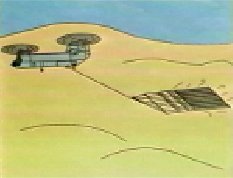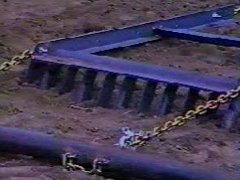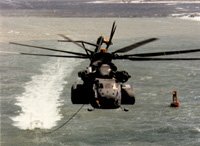Fighting Terrorism: The Helicopter Minesweeper

There is a cheap, proven device that can be used immediately to clear landmines from vast stretches of land with very little risk to man and machine. The Helicopter Minesweeper, designed by Dr. Bill Wattenburg and the Lawrence Livermore National Laboratory, has the added benefit of plowing every bit of ground it touches, making it all but ready for planting.
Video Clip
Note: Bill Wattenburg wonn’t make a dime off of this invention if it is ever used, since he assigned the patent to the government (Regents of the University of California, in this case), as he always does for inventions relating to national defense and security issues. Read the patent yourself to see the proof.
The current demining technologies can not clear large areas of land quickly, and even the mechanized ones still rely on humans prodding the ground with knives and fiberglass sticks at some stage of the process — putting human lives at severe risk.
The Mine Problem in Afghanistan
One of the largest humanitarian problems facing Afghanistan at the moment is the large number of landmines that have been placed there by the Soviets and the Taliban over the last couple of decades. They pose a danger to the citizens, our military, peacekeeping forces, and are keeping precious land from being used for farming or ranching.
Three of our soldiers have already been maimed by landmines in areas that we thought were cleared — obviously, our existing techniques are not removing all the mines, and we must not leave Afghanistan until we have made it safe for the population to use all of their land again.
Please contact your congressional representatives to ask that they demand that the Army or Marines use this device in Afghanistan immediately!
Helicopter Minesweeper Design and Operation
The chain-matrix minesweeper is a very simple design. The device consists of a matrix of medium
chain, with special snag-proof digging knives attached near the front, and a blanket harrow at the rear.
 These knives reach 6-inches into
the soil, pushing the dirt and any objects buried to that depth up above the chain matrix. If pulled at
a high enough speed, this action will cause any mines that aren’t detonated on contact with
the digging knives to bounce on the rear blanket-like portion of the device, where they will most likely
detonate.
These knives reach 6-inches into
the soil, pushing the dirt and any objects buried to that depth up above the chain matrix. If pulled at
a high enough speed, this action will cause any mines that aren’t detonated on contact with
the digging knives to bounce on the rear blanket-like portion of the device, where they will most likely
detonate.
The digging knives are set at a very particular angle, and have steel bars that trail from them. The combination of these two design features forces the knives to dig in to the dirt when pulled forward, yet allows the whole knife assembly to pivot forward when the knives run into anything to solid and heavy to lift or cut through, riding over the top of it. This prevents the chain-matrix assembly from getting snagged and pulling the helicopter to the ground as a result. Once past the object, the assembly falls back into the right orientation and the knives once again start digging.
Because of the sparse and flexible construction of the minesweeper, explosions will do very little damage to the device, and it will continue to function even if some of it has been destroyed. Any damage can be easily repaired on-site with simple welding tools or even by just bolting broken sections of chain back together. No other demining devices can withstand multiple blasts from anti-personnel and anti-tank mines and either remain functioning or be repaired so easily.
Response to Criticism
There are many who say this helicopter minesweeper can’t possibly work; that a helicopter would be too vulnerable to explosions when towing the minesweeper on a 500-foot long cable. But these naysayers obviously haven’t talked to the Navy, which has been towing hydrofoil mineclearing sleds at sea on a regular basis since 1971—at the end of a 450-foot tow line. And the Navy began testing helicopter minesweepers as early as 1951. With the Navy having 50 years of experience towing minesweepers behind helicopters, the Army —experts” don’t have many excuses left they can use.
Please call on your U.S. Congressional representative and Senators to demand that our military use this helicopter minesweeper in Afghanistan immediately.
What the critics say, and the truth, according to Dr. Wattenburg:
- Exploding mines will damage the helicopter, even on a 500-foot tow line
 Then
has the U.S. Navy been doing this for damn near 30 years (since 1973, in Vietnam) at sea? The Navy uses the
MH-53E “Sea Dragon” heavy-lift helicopter to tow
the MK 105 hydrofoil mine clearing sled at
sea (on a 450-foot tow line). This helicopter has a tow-line capacity of 30,000 pounds—easily capable
of handling the 25,000 pounds of force the full-size chain-matrix minesweeper requires. This helicopter is basically
a modified version of the CH-53 “Super Stallion” (a.k.a. the “Jolly Green Giant”) used
by the U.S. Marines. Dozens of these helicopters are probably already in and around Afghanistan.
If the Marines are too macho to learn from the Navy “Sea Dragon” pilots, then
I’m sure any of our commercial heavy-lift helicopter pilots would be happy to oblige.
Then
has the U.S. Navy been doing this for damn near 30 years (since 1973, in Vietnam) at sea? The Navy uses the
MH-53E “Sea Dragon” heavy-lift helicopter to tow
the MK 105 hydrofoil mine clearing sled at
sea (on a 450-foot tow line). This helicopter has a tow-line capacity of 30,000 pounds—easily capable
of handling the 25,000 pounds of force the full-size chain-matrix minesweeper requires. This helicopter is basically
a modified version of the CH-53 “Super Stallion” (a.k.a. the “Jolly Green Giant”) used
by the U.S. Marines. Dozens of these helicopters are probably already in and around Afghanistan.
If the Marines are too macho to learn from the Navy “Sea Dragon” pilots, then
I’m sure any of our commercial heavy-lift helicopter pilots would be happy to oblige.- The chain-matrix was not used in Kuait, so it must not be any good
- The device was available, but the mercenary contractors who took the Kuait job, with full involvement of Kuwaiti middlemen, chose to clear the minefields in more expensive and dangerous ways. They used soldiers from Egypt and Pakistan, whose countries were more than willing to supply them in exchange for hard currency. More than ten times more money was spent as would have been required to clear most of the minefields in the desert. But 6–8 of these soldiers were killed each month.
- The chain-matrix won’t work in all areas.
- False. It has been tested in sticky clay soils, hardpan soils, and in rough terrain covered with dense brush, as you can see in the video above. And while it is true that it will not work in areas such as forests, there aren’t any other devices that will work there either! The most important areas that need to be cleared are easily accessible to a helicopter towing this device. Areas such as farmlands, for instance. The chain matrix will work even over rocky and brushy terrain as well as open areas and roadways. The Pentagon does not have any other equipment or schemes that can do this with no danger to minesweeping personnel.
- The helicopter might crash if the chain-matrix gets snagged
- False! First, heavy-lift helicopters routinely use automatic disconnect devices in the tow line that automatically release if too much force is applied. In addition, the special design of the digging knives (the only portion that cuts into the ground) causes them to tilt up and ride over any obstacles that would otherwise snag it.
- Any mine clearing device must be 100% effective
- Not using the most effective clearing technology means that soldiers must put their lives at extreme risk. The easily demonstrated fact is that the chain matrix can sweep a 16-foot wide area at 15 mph and eliminate all trip wires and most or all anti-personnel mines.
This page was last modified on .
Related InformationThe helicopter minesweeper was first covered in the article, “Clearing land mines by Helicopter”, which appeared on the front page of the San Francisco Chronicle on 8 March 1991. The chain-matrix minesweeper was awarded U.S. Patent 5,183,119; Anti-snag plowing system in 1991. Additional background can be found in a section of a background report on Dr. Wattenburg. Read a letter that Dr. Wattenburg wrote to the chief enginner of the Army—Lieutenant Colonel Charles L. Toomey—back in 1996. An Answer to Bosnia’s Land Mines—In a December 1995 letter to the S.F. Chronicle, Bill rails against inaction and indecision on using his mine-clearing inventions to save lives in Bosnia. You can read about the U.S. Navy’s Airborne Mine Countermeasures (MCM) Systems, including the MK 105 helicopter-towed hydrofoil sled; or an article about the helicopter minesweeping operations from 1974. The Smithsonian’s Air & Space magazine published a great article on the operation of the Navy’s helicopter minesweeper, entitled “The Big Sweep” in its June/July 1996 issue (Vol. 11, Issue 2, p. 24). Also interesting is the Airborne Mine Countermeasures Web site. |